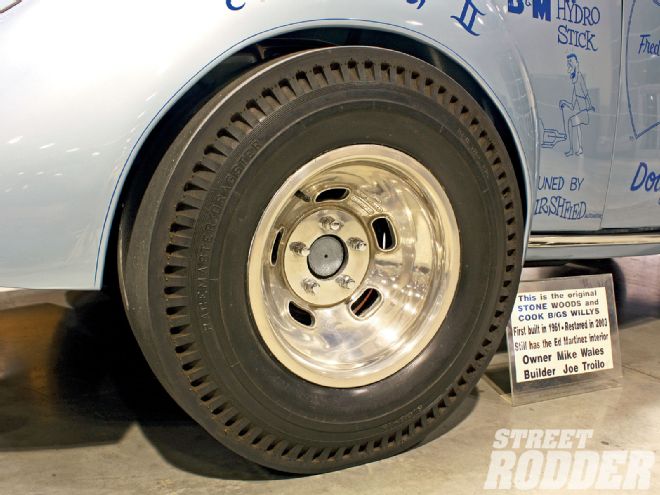
Probably no word lights a hot rodder's charge more than the Halibrand name. Not only is it the most hallowed of all in hot-rodderdom, it's probably the only chunk of real estate where the high-tech and traditional movements find common ground. During its ownership by Ted Halibrand from 1947-79, Halibrand Engineering cast parts for just about every racer-even boats. But of those, two things lent themselves to the hot rod: the company's quick-change axles and its wheels. And of those two, the wheels hold probably the biggest sway.
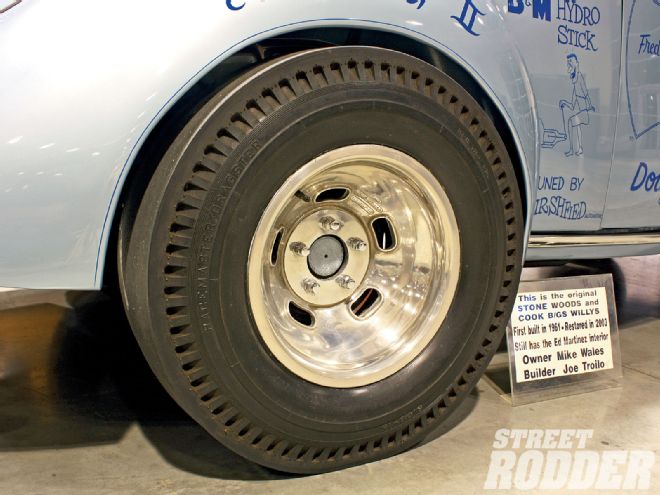
As well as we know those wheels, there really isn't that much published about them. The information is there, it's just that not much of it has been compiled in bodies of information. That's a shame, really. What good is the Halibrand Engineering legacy if no one knows it?
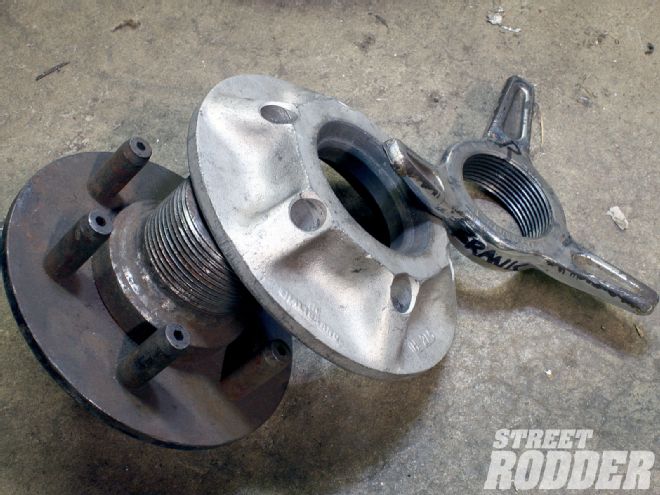 The following is probably Ted's greatest contribution to the racing world. He made a hub with the Rudge's thread, but instead of keying the hub and wheel with splines he drilled them for the midget-standard 6x5 pattern dictated by the T drums. Provided the corner had a brake, it first slides over the pins followed by the wheel and the pressure plate. The knock-off nut held everything together. This changed everything.
The following is probably Ted's greatest contribution to the racing world. He made a hub with the Rudge's thread, but instead of keying the hub and wheel with splines he drilled them for the midget-standard 6x5 pattern dictated by the T drums. Provided the corner had a brake, it first slides over the pins followed by the wheel and the pressure plate. The knock-off nut held everything together. This changed everything.
This is in no way a comprehensive catalog of Halibrand wheels. If not impossible, it would certainly be tedious due to the countless unique variations. Eric Vaughn, who produced wheels inspired by Halibrand's designs, summed it up best: "Just about the time you think you've seen 'em all, another style shows up." Instead, this is a sort of glossary of the more popular and noteworthy examples. To keep this showcase concise, we're concentrating on the wheels the company produced when it was under Ted Halibrand's purview.
The reasons why we're concentrating on the period when he ran Halibrand Engineering are both long and short. According to Dain Gingerelli, who wrote a piece about Halibrand in the Jan. '93 American Rodder magazine, the demand for Halibrand equipment diminished through the '70s since many of the mid-engine Indy cars-the staple of Halibrand's business-started coming from England. Furthermore, the shop's foreman and Halibrand's brother, Teddy (yes, he had a brother named Teddy), died in the mid-'70s. According to Bob Falcon, who worked for Halibrand Engineering for 30-plus years, Halibrand sold the name and patterns to ARC Industries in 1979, which moved the operation to El Cajon, California.
According to Eric Vaughn, ARC was sold to Jackman Industries in 1982. That name is similarly familiar in the wheel world: it made stamped-steel and spun-aluminum wheels through the late '70s and '80s. The mere thought makes us cringe, but Jackman's employees allegedly re-purposed many of the company's exquisite mahogany patterns as fuel for bonfires at various desert outings. In his article, Gingerelli noted that Jackman sold the company to Wayne Mitchell in 1988 and Mitchell soon after brought in Barry Blackmore and the duo eventually sold out to Richard Lejeurrne. Everyone has a different reason why it happened, but Halibrand Engineering went into Chapter 7 bankruptcy in the mid-'90s and ceased to exist as a part manufacturing company. Lejeurrne rekindled the Halibrand name soon after, but the new company's name is Halibrand Perfomance, not Halibrand Engineering-the company Halibrand founded.
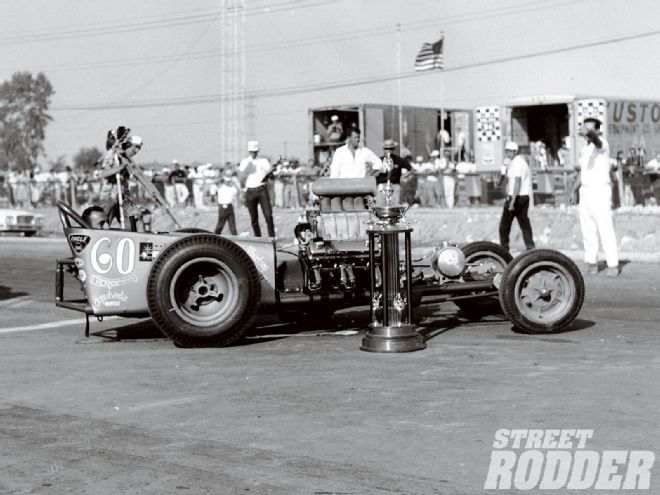 Bolt-on front wheels were exceptional on dragsters because they required heavy hubs, which dragsters didn't need since they generally didn't run front brakes. So Halibrand made wheels that incorporated the hub itself, as seen on Jack Mendenhall and Bob Andersen's digger, the Pea Soup Andersen Special. Note the holes in the rear wheel. Though known familiarly as windows, Bob Falcon noted that the company referred to them and those that followed as brake vents.
Bolt-on front wheels were exceptional on dragsters because they required heavy hubs, which dragsters didn't need since they generally didn't run front brakes. So Halibrand made wheels that incorporated the hub itself, as seen on Jack Mendenhall and Bob Andersen's digger, the Pea Soup Andersen Special. Note the holes in the rear wheel. Though known familiarly as windows, Bob Falcon noted that the company referred to them and those that followed as brake vents.
But we much prefer the short version: Halibrand Engineering under Ted Halibrand cast wheels from magnesium exclusively (all subsequent owners cast the wheels from aluminum). And for the record, we're sort of intrigued by metal that can burn.
Our good bud Greg Sharp, at the NHRA museum, has a photo collection to end all, and a number of the cars in those photos sport Halibrand wheels. Trimmer Paul Reichlin (Cedardale Auto Upholstery) and machinist Buffalo (Buffalo Enterprises) let us snap shots of their collections. And to us, photos are reason enough to run a story about the most hallowed name in the hot rod world: Halibrand Engineering. Enjoy!
Anyone who knows the Halibrand legend understands that anything that bears Ted Halibrand's name is borderline priceless. That wasn't always the case. In fact, some say that Halibrand was just as committed to making parts affordable for common racers as he was making those parts light and strong. A story about Halibrand's early years explains it best.
You could say Halibrand was a child of the race car. He was born in 1916 in Paterson, New Jersey, home to one of the most celebrated dirt tracks through the '30s, Hinchcliffe Stadium. Just before World War II he moved to Southern California, and while working as a service rep at Douglas aircraft he started dabbling with race cars-he even owned and raced a Kurtis Offenhauser midget. Naturally, the outbreak of war sidelined his racing aspirations; however, the war effort served him well. After all, working at Douglas put him front and center as technology unfolded.
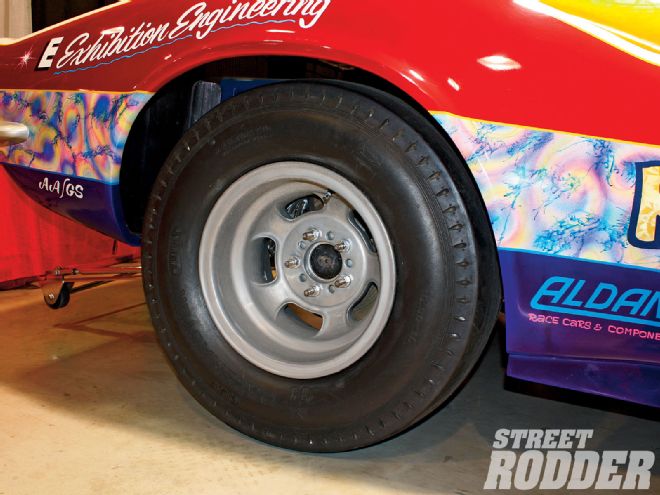 Halibrand frequently modified existing tooling for low-production runs, like the wheels on Mike Mitchell's AA/Gas digger. They're the same shape as the 16-inch wheels on the Weiss and Larkin, however, the lips disappear as the pattern makers modified the tooling to make them 15s.
Halibrand frequently modified existing tooling for low-production runs, like the wheels on Mike Mitchell's AA/Gas digger. They're the same shape as the 16-inch wheels on the Weiss and Larkin, however, the lips disappear as the pattern makers modified the tooling to make them 15s.
Just after the war-some say 1947-Halibrand rented a building in Culver City, California, and set up shop as Halibrand Engineering. He started out making wheels and various parts for race cars, specifically midgets like the one he ran before the war, but what made his parts stand out was due to his background. As a cog in the wheel of Southern California's bustling aerospace industry, Halibrand had hands-on experience with advanced materials and methods perfected for the war effort. While builders at the time made midget wheels by welding Model T brake drums to 12-inch-diameter rims, Halibrand made his the same way Douglas did for its Dauntless fighters. He cast them with a lightweight material as mysterious today as it was then: magnesium.
These early wheels don't look like the windowed mags we've come to know and it's on account of the wheel mounting system at the time. Midget builders employed modified Ford and Chevrolet hubs in their cars, but Indy builders used a hub purpose-built for a mounting system pioneered by British wheel maker Rudge Whitworth. Its design consisted of an axle hub and wheel hub broached with matching splines-basically the same as under an old Jag, MG, or Austin-Healey.
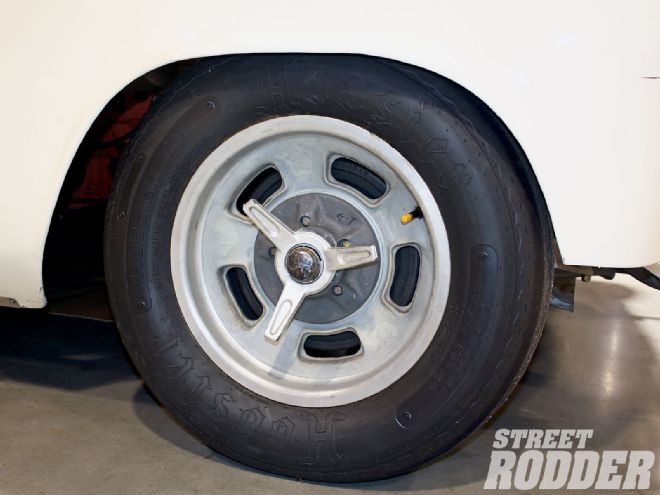 As the oval vents grew in size, Halibrand began to offer another wheel style with a square-edge brake vent. Ostensibly, the square edges required less material, which ultimately produced a lighter wheel. The smaller oval shape just inside the brake-vent opening suggests that the pattern makers changed just the face pattern so they could make both styles with one set of rear patterns.
As the oval vents grew in size, Halibrand began to offer another wheel style with a square-edge brake vent. Ostensibly, the square edges required less material, which ultimately produced a lighter wheel. The smaller oval shape just inside the brake-vent opening suggests that the pattern makers changed just the face pattern so they could make both styles with one set of rear patterns.
To make his wheels fit the existing hubs, Halibrand broached the Rudge Whitworth spline dimension directly into the castings. As proven as the design was in steel, the reliability didn't translate to magnesium; the material's greater expansion rate than the steel hub compromised the fit between the two, causing the splines in the softer magnesium to fret and crack.
Ostensibly, due to this failure, Halibrand re-thought the entire wheel mounting system. Remember that part about his commitment to making parts affordable? He retained the threaded snout similar to the Rudge design; however, instead of using splines, he keyed the wheel to the hub with six pins set in the same pattern that the Midget wheels used.
The more positive-engaging design gave Halibrand's wheels several advantages: they were stronger, lighter, and required far less maintenance. Whether or not it was due to Halibrand's design, Rudge Whitworth, the company that devised the earlier spline-drive design, used principles similar to Halibrand's to create the wheels and hubs for Porsche 356 race cars and Mercedes-Benz' 300-Series gullwings and roadsters. As further proof of Halibrand's design's merit, it's been said that Halibrand wheels with their pin-drive system were on 19 Indy 500 winners.
Though many claim that it was the wheel failure that inspired Halibrand to rethink the hub design, just as many others reflect on Halibrand's drive to make parts affordable to the common racer-even if they drove an Indy car.